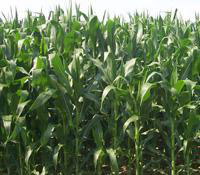Corn Demand Likely to Test Production
Corn Demand Likely to Test Production

While grain markets are never clear cut, a University of Kentucky College of Agriculture grain marketing specialist believes corn producers will see high demand for their product for the next few years.
Corn used for animal feed – the largest segment of corn usage – is expected to continue to increase due to expanding cattle herds and high demand for meat, said Steve Riggins. At the same time, the new U.S. energy bill virtually ensures increased corn demand for use in ethanol production, further stretching the U.S. corn market.
While demand for corn is expected to continue to increase, however, corn production may be challenged to keep pace, Riggins said.
In the United States, 11 billion bushels of corn was produced this past year – something that’s only been accomplished twice. At the same time, this is likely the last year corn use will be less than 11 billion bushels, barring a crop failure, Riggins said. Therefore, U.S. production can’t keep pace without additional corn acres being planted or unless yields run well above the trend.
Corn use globally has outpaced production in much of the past nine years, reducing storage levels, Riggins said. It is the same for wheat, which is also used for animal feed. The case can be made that global production cannot keep pace with rapidly expanding use, especially at current price levels, unless more acres are brought into production, he said.
“The corn situation looks really interesting over the next four or five years,” he said. “I don’t think we’ve solved the long-run problem of low prices because technology will eventually produce more bushels per acre. But in the short run, and as we use more and more to produce energy, it’s going to become interesting to see where the acres are going to come from to meet the demand because in my opinion, I don’t believe they exist in this country without taking them from somewhere else.”
With little unused farmland available, any additional acres would have to come from land used for soybean production or from acres now enrolled in federal conservation programs. It is unclear whether any of those acres will come back into production under new federal farm programs.
“My point is I don’t believe there is much farmland not in production left out there,” he said. “We may be able to get a few more acres but not too many.”
Soybeans, on the other hand, don’t look as bullish over the next four to five years without substantial increases in uses. There is little increased demand in the developed world for soybeans because of small population growth and well-established diets. Demand, could increase however, if China and other developing countries continue to use more soybeans and if use of soybeans increases dramatically in the United States for soydiesel production as a result of the energy bill.
As a result, Riggins said it could be an interesting tug of war between corn and soybeans for the available crop acres in the United States.
Increased corn production in other areas of the world and advances in technology resulting in higher yields will eventually allow production to catch up with demand, but for a few years corn producers could see some interesting times, Riggins predicted.
